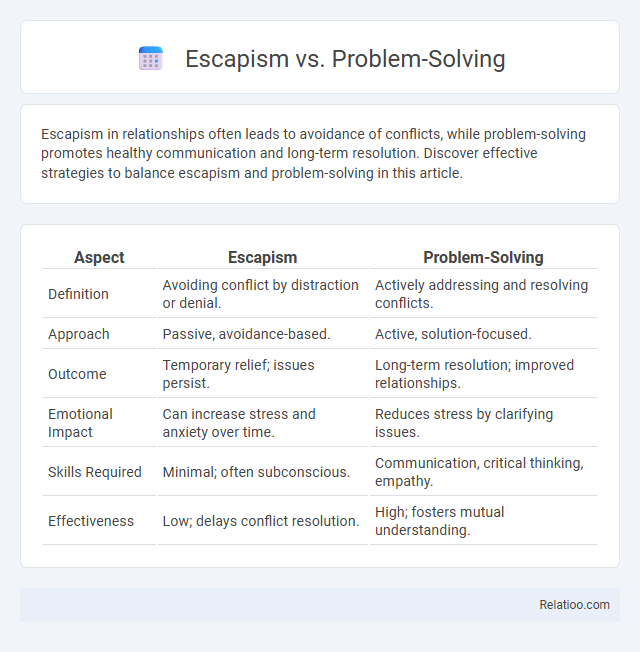Escapism in relationships often leads to avoidance of conflicts, while problem-solving promotes healthy communication and long-term resolution. Discover effective strategies to balance escapism and problem-solving in this article.
Table of Comparison
| Aspect | Escapism | Problem-Solving |
|---|---|---|
| Definition | Avoiding conflict by distraction or denial. | Actively addressing and resolving conflicts. |
| Approach | Passive, avoidance-based. | Active, solution-focused. |
| Outcome | Temporary relief; issues persist. | Long-term resolution; improved relationships. |
| Emotional Impact | Can increase stress and anxiety over time. | Reduces stress by clarifying issues. |
| Skills Required | Minimal; often subconscious. | Communication, critical thinking, empathy. |
| Effectiveness | Low; delays conflict resolution. | High; fosters mutual understanding. |
Understanding Escapism: Definition and Forms
Escapism is a psychological coping mechanism involving the diversion of attention from real-life problems to more pleasurable or entertaining activities. Common forms of escapism include engaging in books, movies, video games, daydreaming, and fantasy, which provide temporary relief from stress or anxiety. Understanding escapism is crucial to differentiating it from problem-solving, as escapism avoids confronting problems while problem-solving actively addresses and resolves them.
What is Problem-Solving? Key Concepts
Problem-solving is a cognitive process that involves identifying a challenge, analyzing possible solutions, and implementing strategies to overcome obstacles effectively. Key concepts include defining the problem clearly, generating alternatives, evaluating options based on feasibility, and executing chosen solutions while monitoring outcomes. Your ability to apply structured problem-solving techniques enhances decision-making and promotes adaptive responses in complex situations.
Psychological Roots of Escapism
Escapism, rooted in psychological defense mechanisms, often emerges from the need to avoid stress, anxiety, or unresolved problems that overwhelm the mind. Unlike problem-solving, which actively engages your cognitive resources to confront and resolve challenges, escapism provides temporary relief by diverting attention to fantasies or distractions. Understanding the psychological roots of escapism helps you recognize when avoidance hinders personal growth and mental health.
Benefits and Drawbacks of Escapism
Escapism offers a mental break from stress by immersing you in activities like reading, gaming, or daydreaming, which can improve mood and reduce anxiety. However, excessive escapism may lead to avoidance of real-life problems, resulting in unresolved issues and increased stress over time. Balancing escapism with proactive problem-solving ensures you maintain emotional health without neglecting practical challenges.
The Science Behind Effective Problem-Solving
Effective problem-solving engages the prefrontal cortex to enhance cognitive flexibility and executive function, enabling individuals to analyze situations critically and devise practical solutions. Neuroscientific research highlights that active problem-solving reduces stress by promoting a sense of control, unlike escapism, which may temporarily alleviate discomfort but often leads to increased avoidance and anxiety over time. Evidence-based strategies such as goal setting, mindfulness, and iterative evaluation optimize neural pathways to sustain motivation and improve decision-making efficacy.
Escapism vs Problem-Solving: Core Differences
Escapism involves diverting your mind from reality through activities like gaming or daydreaming, while problem-solving actively addresses challenges by identifying solutions and taking concrete steps. Your ability to distinguish between these approaches impacts mental health and productivity, as excessive escapism may avoid issues whereas problem-solving fosters growth and resilience. Understanding these core differences helps balance relaxation with proactive coping strategies for effective life management.
When Escapism Becomes Harmful
Escapism becomes harmful when it shifts from occasional stress relief to chronic avoidance of real-life problems, leading to increased anxiety and emotional numbness. Excessive escapism, whether through digital media, substance use, or fantasy, can erode coping skills and delay necessary problem-solving efforts that promote resilience. Effective mental health strategies prioritize balancing escapism with proactive problem-solving to maintain psychological well-being and prevent long-term negative consequences.
Cultivating Productive Problem-Solving Skills
Cultivating productive problem-solving skills involves developing critical thinking, emotional regulation, and resilience to address challenges effectively rather than avoiding them through escapism. Research shows that individuals who engage in active problem-solving exhibit improved mental health outcomes and greater life satisfaction compared to those relying on escapist behaviors like excessive gaming or substance use. Implementing structured problem-solving techniques and cognitive-behavioral strategies enhances one's ability to confront issues constructively, reducing dependence on maladaptive escape mechanisms.
Finding a Balance: Escapism and Real-Life Challenges
Balancing escapism and real-life challenges involves recognizing the therapeutic benefits of temporary mental breaks without neglecting problem-solving responsibilities. Engaging in escapism through activities like reading, gaming, or creative arts can reduce stress and enhance motivation, but excessive reliance can hinder addressing underlying issues. Effective coping includes setting limits on escapist behavior while actively developing strategies to confront and resolve real-world problems, fostering psychological resilience and overall well-being.
Practical Tips to Transition from Escapism to Problem-Solving
Shifting from escapism to problem-solving involves recognizing avoidance behaviors and gradually replacing them with actionable steps to address underlying issues. Prioritize setting specific, manageable goals, breaking problems into smaller tasks, and using mindfulness techniques to stay present and focused. Creating a structured routine and seeking social or professional support can reinforce constructive habits and improve resilience against stress.

Infographic: Escapism vs Problem-Solving
 relatioo.com
relatioo.com